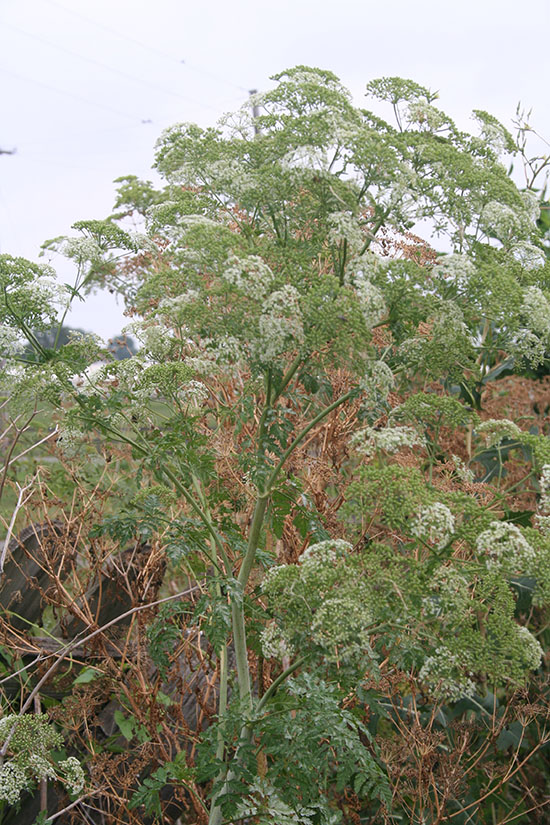Issue 7, June 11, 2018
Weedy Members of the Carrot or Parsley Family– Identify Before You Touch!
Several years ago I was introduced to wild parsnip (Pastinaca sativa). It was growing in the ditch and I was reaching for it when about 4 accompanying family members screamed, "Don't touch! Get back." The plant looked harmless to me like some type of wild carrot, but I learned that day about one more plant I should add to my "don't touch list."
Wild parsnip, or poison parsnip, is not really poisonous; however, it has the ability to cause sun-induced blistering or "burns" on the skin. The sap contains chemicals (furocoumarins) that cause phytophotodermatitis. Basically, if your skin absorbs these chemicals and is then exposed to sunlight, an interaction takes place; the result is reddened burned-like skin and/or blisters. For more information on diagnosing wild parsnip-caused allergic reactions, check out the article, "Burned by wild parsnip," written by David J. Eagan for Wisconsin Natural Resources Magazine at https://dnr.wi.gov/wnrmag/html/stories/1999/jun99/parsnip.htm. It's an interesting read. and the pictures will make you a believer that this plant is surely one to avoid.
I now know that wild parsnip can be quickly distinguished from many of its weedy cousins by its yellow flowers. Also, the leaves are pinnately compound, divided once into more than five leaflets with coarsely sawtoothed edges, and they are hairless.

Parsnip.
Wild carrot (Daucus carota) or Queen Anne's lace, has leaves that are many times pinately compound, finely dissected, and hairy. It also has umbel flowers, but the petals are white not yellow. You can fill vases with the pretty, lacelike flowers and most likely remain blister free. Maybe add food coloring to the water to change the flower color and relive childhood memories. But resist the urge to plant this in your garden as it spreads rampantly.
Poison-hemlock (Conium maculatum) is a similar, related species. This time the name is accurate as the entire plant is very poisonous. All parts contain toxic alkaloids that cause respiratory failure when ingested. Also reported are birth defects in livestock. Fortunately, this plant should leave you blister-free also. Like wild carrot, the clusters of flowers are white but smaller, only 1.5 to 2.5 inches compared to 3 to 6.5 inches. Smell the leaves of wild carrot and you'll smell a carrot-scent. Likewise, wild parsnip smells like a parsnip. Smell a crushed poison-hemlock plant and you'll smell a disagreeable odor. But before you crush it, look at the stems. Poison-hemlock has smooth, purple-spotted, waxy, ridged stems that are hollow between the nodes. Wild carrot stems are quite different: bristly hairy, vertically ribbed, purple-spot-free and not hollow. Wild parsnip stems are usually somewhat hairy and grooved. Stem size makes up for the smaller flowers; poison-hemlock grows erect, 2 to 7 feet tall, while wild carrot usually reaches only 1 to 3 feet in height. Wild parsnip falls in the middle at 2 to 5 feet tall. Poison hemlock is listed in the Illinois Exotic Weed Act.

Poison hemlock.
These three plants are all biennial weeds commonly found in roadsides, waste areas, pastures, meadows, and even landscapes. Each begins as a rosette, bolts in the second year, and produces many seeds. The underground portion consists of a fleshy taproot.
A few more distant cousins – It's a big family
Another member of the Apiaceae family, spotted waterhemlock (Cicuta maculata), is often confused with wild carrot and poison-hemlock. This plant, however, will have a cluster of fleshy taproots at its base. It is a perennial and is primarily found in wetter areas. All parts of this plant are poisonous if eaten.
Cow parsnip (Heracleum maximum or H. lanatum) is a biennial that is more common north of I-80. It too tends to be found in wetter areas. This plant reportedly causes dermatitis in humans; cattle can be poisoned by eating the leaves – which are enormous, up to 16 inches long and 12 inches wide! Fortunately, it's not considered to be very invasive or weedy and is actually a somewhat conservative native species.
One last quite impressive relative is giant hogweed (H. mantegazzianum). What is so impressive? Its massive size – 10 to 15 feet tall! It makes cow parsnip at only 4 to 5 feet tall look like a dwarf. This Illinois listed Exotic Weed and Federally listed noxious weed also causes large painful blisters! Pictures of blisters and burns abound on the internet. Graphic pictures cannot be unseen, but they will convince and remind you that giant hogweed is quite dangerous. This plant is rare in Illinois, but there have been a few reported sightings of this plant in the northeastern part of the state. If you believe you have giant hogweed, please DO NOT TOUCH it, says Kelly Estes, State Survey Coordinator for the Illinois Cooperative Agricultural Pest Survey Program. You can report sightings to her at kcook8@illinois.edu or to Chris Evans at cwevans@illinois.edu. Pictures of the leaves, flower heads, and stem will help Kelly and Chris with identification. Contacting the Department of Agriculture is also advisable.
Although many of the plants in this family have friendly sounding names, they can be fooling. Always handle unfamiliar plants with caution. A good weed ID book can be beneficial. Chris and Kelly have created a nice guide to assist with identifying many of the species discussed in this article: https://uofi.app.box.com/v/GiantHogweedID
While hand pulling or working around plants that cause skin conditions, wear long pants, long sleeves and gloves. Working after sunset can help prevent blistering and burns too. While mowing can reduce seed production, string trimmers are not recommended as small pieces can be thrown towards unprotected skin easily. Applying a herbicide to the rosette in the early fall or late spring can control many in this family. Repeat applications may be necessary. Suggested options include 2,4-D, dicamba, triclopyr, MCPP, MCPA, or metsulfuron. Spot treatments of glyphosate can be effective as well. As always, carefully read and follow all label directions. (Michelle Wiesbrook)
Author:
Michelle Wiesbrook